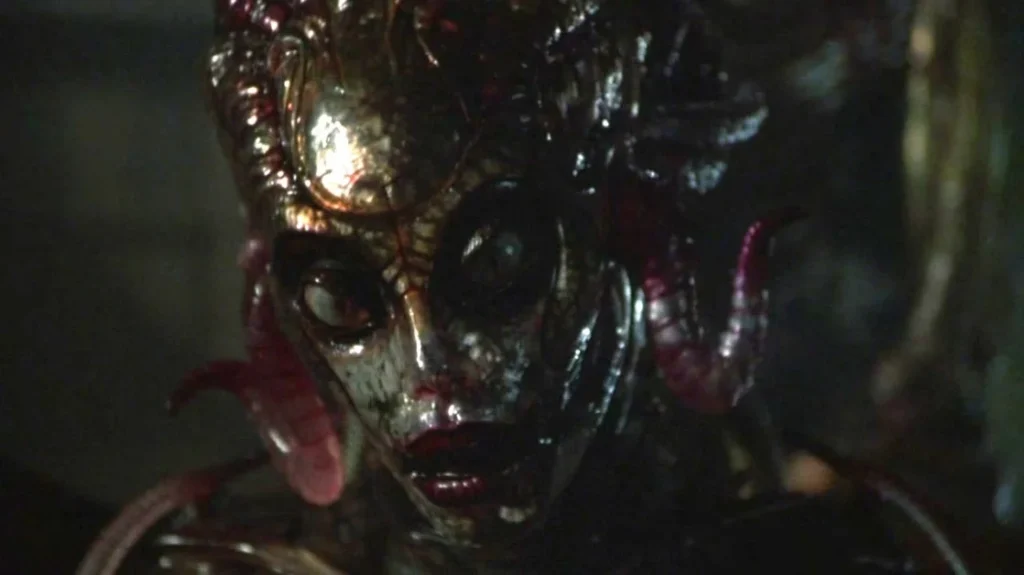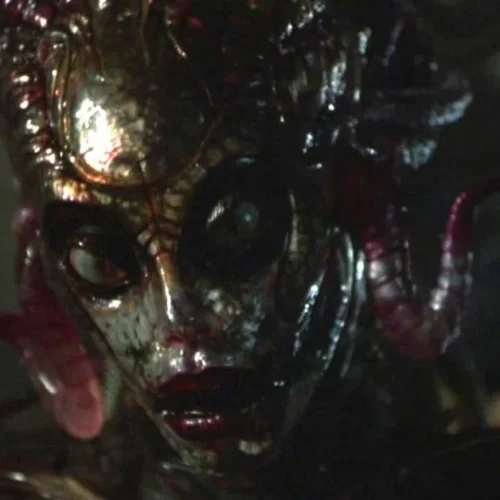Filmmakers have long been fascinated with the questions posed by the hypothetical existence of extraterrestrial life. What would the discovery of intelligence from beyond the stars reveal to humanity about their place in the cosmos? What power would our ancient faiths maintain in the face of the revelations that would be occasioned by first contact with beings from another planet? What effect would these strange visitors have on our sciences? On our arts and our politics? But it was with the release of Ridley Scott’s Alien in 1979 that the most important question was asked: what would happen if somebody fucked one? Scott’s focus on his xenomorph’s tripartite lifecycle occasioned a whole slew of cash-ins and rip-offs focussed on little green men and their little green men and what would happen if their material was introduced into the gene pool. Results ranged from the high budget sleazy fiasco by Tobe Hooper, Lifeforce (1985), to the low budget sleazy fiasco by Roger Corman, Galaxy Of Terror (1981), via 1982’s Xtro, a film so bizarre, chintzy and repellent that it achieves a kind of befouled majesty. The theme of aliens making first, second and third contact has been mined to differing levels of sordidness ever since. 1995’s Species manages something unique though. An ‘R’-rated sci-fi horror movie, with an absurdly overpowered cast, a decent budget and art design by H.R. Giger – the creator of Scott’s iconic creature – that still manages to feel like the kind of seedy, sweaty b-movie you would have caught out of the corner of one eye in a grind house fleapit circa 1983. And one that went on to be a massive hit, resulting in no less than three sequels.
Species is one of those “they don’t make ‘em like that anymore” movies. It belongs in a class of mid-budget, semi-respectable genre film making that no longer exists in today’s industry. Back when a veneer of post-Michael Crichton airport novel worthiness could be stretched over projects like The Relic, or Del Toro’s Mimic (both 1997), or Crichton’s own effort, the deeply disjointed and weird Sphere (1998), a thin meniscus of ooh-la-la was often just enough to attract decent actors and some investment, before the resulting movies would go on to a half-life as the kind of basic slot filler you might catch a glimpse of as you skipped past Film 4 late at night. What separates Species from this subgenre of mid-brow trash is its underlying theme. And how hard it works that theme. And then works that theme. And then works that theme. Because Species is a film about shagging. What was only implied in Alien is put front and centre here, in a movie that could only have been made in the horrible 1990s, via a genetic accident that crossbred Scott’s chilling masterpiece of galactic terror with a “pre-owned” issue of FHM.
In the stupid, stupid world of Species, first contact with extraterrestrials was achieved in 1993, and to show their good faith our new alien friends gifted humanity a never ending fuel source (which I’m sure the United States government will be unveiling to the public any day now) as well as the key to unlocking the mysteries of alien DNA, which science – personified here by Sir Ben Kingsley’s Xavier Fitch – had already used to create a human/alien hybrid. But, no! It escapes! And Fitch must put together a rag-tag team of scientists, psychics and shady contractors to track the alien through the streets of Los Angeles and kill it before it breeds, dooming humanity for reasons of vaguely explained science. It’s not an original premise, Jack Sholder’s The Hidden did something very similar in 1987, but thankfully Species is the kind of film where if you were to have a drink every time one of the characters did or said something stupid you’d be unable to clap your own hands within twenty minutes of the opening credits. Therefore, the resulting chase has the madcap to-ing and fro-ing of an adult themed episode of Scooby Doo, as our team of specialists bicker, bonk and drink themselves insensible while following the alien’s path of sexy, sexy destruction.
Sil, as the alien has been named and as played in fully grown form by Natasha Henstridge, wants a baby. “I think she’s trying to mate…” confirms the team’s molecular biologist “…reproduce…” she helpfully clarifies. What this all boils down to is a series of scenes in which our heroes arrive too late to a scene in which some poor sod has been fucked, killed or fucked and then killed by the runaway extraterrestrial strumpet, who has a habit of revealing her true physical form during intercourse and ripping her partners to bits. This, obviously, being portrayed in a way that ensures maximum coverage of Henstridge’s naked body and maximum VFM for any sweaty teenage boys who queued outside the cinema in the July sun [An oddly specific detail, Ed] in the hope of getting to glimpse a boob or two.
While H.R. Giger’s design for the alien is influenced by the 90s fetish scene, her nipple whips and black leather sheen copied straight from the dancefloor of Torture Garden or the pages of Skin Two, the vision of the sensual presented in Species is a drably and hilariously lumpen one. Sil’s sex dreams – to which luckily we are privy – thrum with the erotic power of the middle-aged bloke, featuring Henstridge with no clothes on, a fog of dry ice and Michael Madsen stripped to his vest wearing the expression of a man who’s just lifted the lid off a cistern. It’s like peering into the mind of a frustrated husband, daydreaming an affair with the au pair while he mows the lawn. The sex is plentiful and graphic, but in that peculiarly un-arousing way that 1990s cinema excelled at, all gasping noises, slow motion writhing and skilfully placed bedsheets to obscure any willies.
But let’s talk about that insanely over-qualified cast, because there are two Oscar winners in this thing, and they are both bringing a furnace-worth of heat. Kingsley, introduced crying a solitary unscientific tear while attempting to murder a twelve year old girl with cyanide gas, gives a performance rich in the halted cadence, mysterious smiles and sudden LURCHES in volume that typify a classical actor having fun with some extremely daft material, all while saddled with an inscrutable American accent. Forest Whitaker’s approach to playing the team’s “sensitive” (read: conveniently psychic when the plot needs him to be, totally useless at all other times) is, to put it delicately, perhaps not the sort of portrayal of the mentally stigmatized that would go down well today. I say ‘perhaps’ because while I’m sure his performance is offensive on some level, it’s impossible to work out exactly who to because Whitaker’s Dan being such an unworldly smorgasbord of tics, twitches and cryptic pronouncements that he doesn’t resemble anybody who has ever lived. Bringing up the rear we have Alfred Molina – three time Tony award nominee – as a permanently priapic anthropologist; Michelle Williams – Oscar nominee – as the young Sil; Henstridge – MTV Award winner for Best Kiss, 1995 – gliding through the film like a bodacious Road Runner being chased by a pack of lecherous Wile E. Coyotes, and a coracle of recognisable character actors, such as Esther Scott’s extremely unfortunate train conductor.
But the biggest baddest coyote on the range is Michael Madsen, whose character – Preston Lennox, Manhunter – is introduced as one of those vague “government operative” types that these types of film always require. A contractor with a set of highly dangerous skills learned in the most Godforsaken parts of the globe, and a perma-smirk so endlessly punchable you can see why he had to learn them. Madsen loiters through the film like a man trying to sell drugs to school children, firing guns in hotel corridors, laughing at his own jokes, having undeserved sex with the molecular biologist (Marg Helgenberger) and in a thematically appropriate manner acting like a massive dick. A terrific old-school character actor with a dishevelled charm that could be leveraged to real effect, Madsen is the living personification of the film’s grottily prurient sexual climate and Species would be nowhere near as much fun as it is without him. He will be missed.
As enjoyable as all this nonsense is, it’s important to point out that Species also looks classy as hell. Director Roger Donaldson – also responsible for Cocktail (1988), Dante’s Peak (1997) and the armed resistance drama Sleeping Dogs (1977) – gets the job done elegantly while Andrzej Bartkowiak lights nighttime L.A. with a soft, rich glow. Giger’s design for Sil is divisive. I’ve never much cared for it, particularly in its later, more CGI-heavy incarnation, but his “Dream Train” sequence, which he paid to film with his own money after finding out it would be cut otherwise, is an enjoyably loopy and surreal wrinkle in the film’s steady flow. Species is also, importantly, really gross. Sil’s cocooning process is vividly and stickily depicted and the various death scenes – various sexy death scenes – in which she goes through inappropriate suitors like a bailer through a wheat field, have a compellingly unpleasant and gloopy sexual energy to go along with their splatter. There’s a markedly pulp-feminist edge to the carnage as well, as this wronged and pursued woman, bred to die by men in a laboratory, emasculates and murders a bunch of Los Angeles’ most vapid and predatory male residents. Don’t get me wrong, Species is not a liberatory masterpiece, intentionally or unintentionally, but its inversion of the rape/revenge dynamics we usually see in this type of storytelling shouldn’t be ignored.
And there’s a terrific 90s club scene, to boot. Club scenes in old movies are portals into an exaggerated past, where versions of the day’s trends are smushed into parodies of themselves by art direction and cluelessness and come out looking like nothing that ever existed. The club in Species is called, of course, The Id, and it is a supreme example of this kind of thing, being pitched somewhere between Cirque Du Soleil, an oligarch’s boat wedding and the Cyberdog store in Camden market. It’s a prismatic representation of a singular moment in the culture, and one that isn’t coming back. Species itself occupies a similar position, a lurid, hypersexualised testament to the times in which it was conceived that nowadays feels like something beamed from another planet, where recipients of the highest honour in the land act their tits off in big budget sequels to Inseminoid. Horror, while ever popular, is a different genre now and a much more self-aware one. Any future cinematic dabblings in the kind of spuriously grown-up blockbuster trash that Species represents would come complete with air quotes, a vastly lower budget and be much less enjoyable, and why bother with that? Especially when you can just watch Species 2. Now that film is a real piece of trash.



